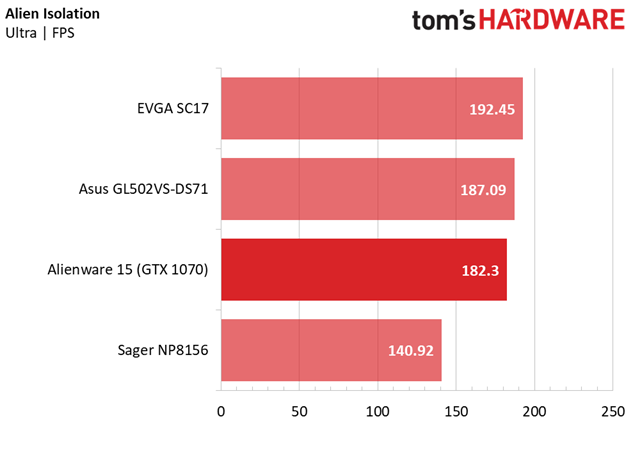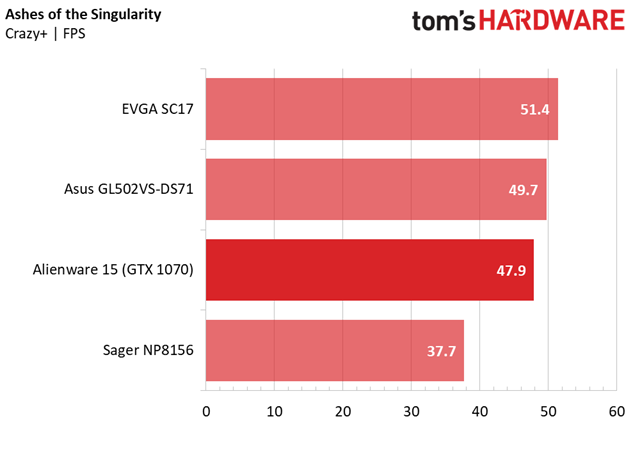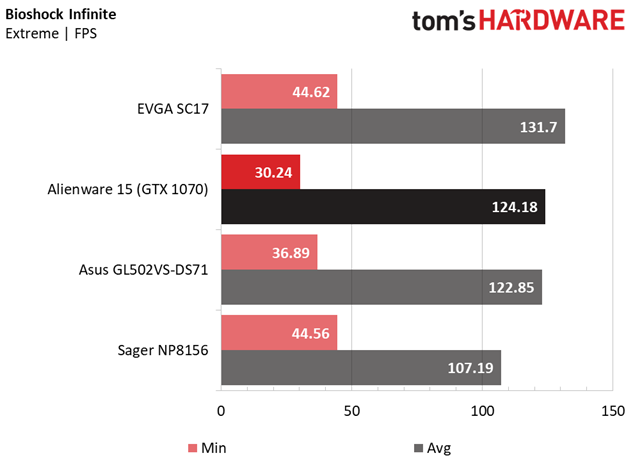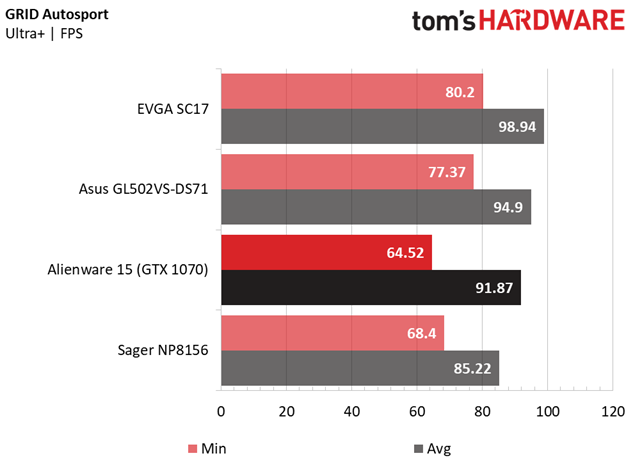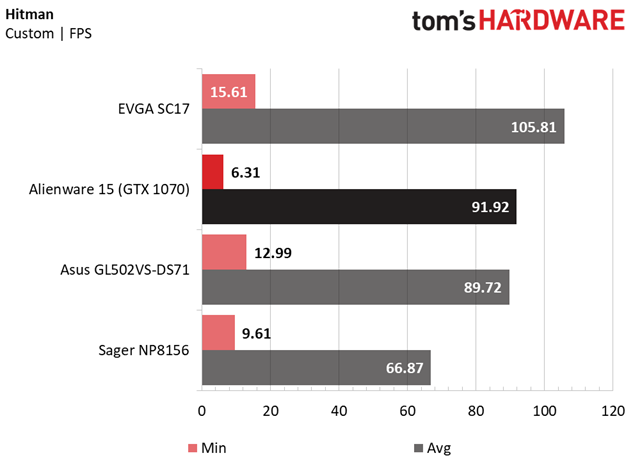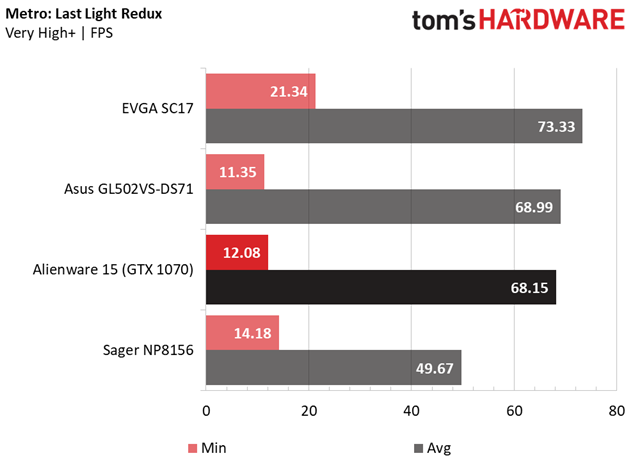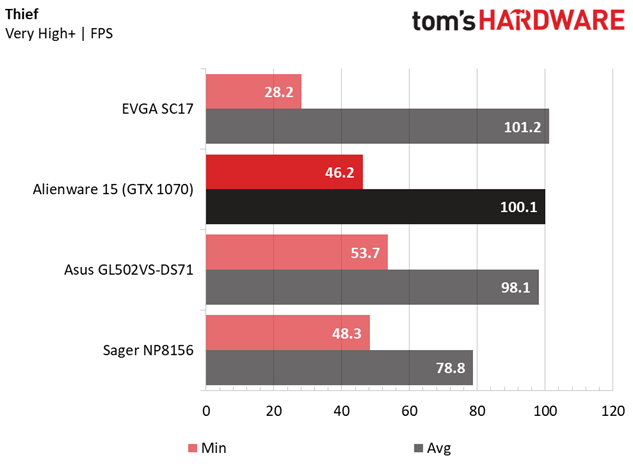Alienware 15 (GTX 1070) Gaming Laptop Review
Why you can trust Tom's Hardware
Gaming Benchmarks
Alien: Isolation
To ease our way into the gaming benchmarks, we have Alien: Isolation, in which just about any modern gaming system can succeed. The GTX 1070-based laptops produce a tight performance spread, with the Alienware 15 scoring about 2% slower than the Asus Strix GL502VS-DS71 and about 6% slower than the EVGA SC17. The 5 FPS discrepancy between the Alienware and Asus are easily chalked up to margin of error, but the EVGA's 10 FPS lead is much more substantial, and likely due to the overclocked i7-6820HK. The Sager NP8156 trails by about 23%, but 140 FPS is nothing to scoff at.
Ashes of the Singularity
In Ashes of the Singularity, the Alienware laptop takes third place yet again by a handful of frames, but all three of the GTX 1070 laptops will require an extra ounce of performance to surpass the 60 FPS threshold; even the EVGA i7-6820HK only provides an additional 3 FPS. To achieve 60 FPS, you'll have to dial back a few settings, such as anti-aliasing. The same can't be said for GTX 1060-based laptops, however. The Sager delivers 10 FPS less than the Alienware system, which amounts to about 21% less performance. The graphical compromises the Sager will require to reach 60 FPS will be greater.
Bioshock Infinite
Bioshock Infinite is similar to Alien: Isolation in that high frame rates are easy to achieve, so your biggest bottleneck will be your CPU. The Alienware and Asus Strix produce virtually identical results, but the EVGA SC17 pulls a 7 FPS lead. It should be noted that the GTX 1070 provides just enough performance for the Alienware laptop to match its 120Hz refresh rate.
DiRT Rally
DiRT Rally tells a similar story, with the Alienware 15 taking second place and the Asus trailing by a hair's width. The EVGA SC17 takes the lead once more because of its more robust processor, but only by a couple of frames. On the other hand, the NP8156 and its GTX 1060 score between 26% and 28% slower than the GTX 1070-equipped competition, which pulls its performance below 60 FPS. It can easily surpass that with light tweaking.
Grand Theft Auto V


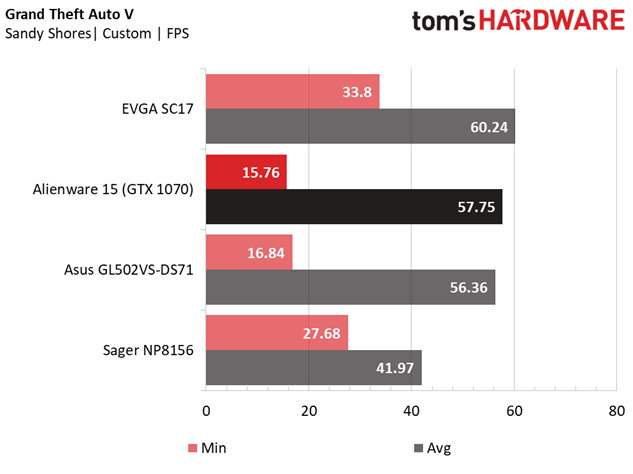
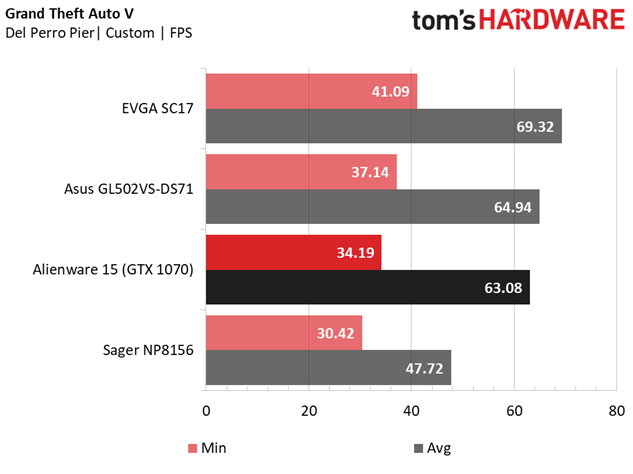

During our review of the Acer Aspire VX 15, we introduced test results based on reduced graphical settings if a laptop failed to achieve an average FPS of 45. GTX 1070-based laptops usually pass this minimum requirement in our benchmarks, save for one game.
Grand Theft Auto V has the distinction of being one of the most demanding games in our suite, and even the most powerful laptops will have to cut back on graphics settings to maintain a solid 60 FPS. In most scenes, the Alienware, Asus, and EVGA systems maintain above 45 FPS, but during the Vinewood Sign scene, their averages fall well below that. This is because the scene renders many distant objects and landscapes, which taxes resources considerably. By reducing the benchmark settings to the normal preset, we're able to breeze by 45 FPS. Unfortunately, we don't have reduced setting data for the SC17 or NP8156, because we've sent them back.
GRID Autosport
GRID Autosport performance is platform-based, but oddly enough, it gives systems with high GPU clock rates a slight edge. The Alienware manages to maintain over 90 FPS average, and never dips below 60 FPS. However, the Sager NP8165 comes dangerously close to matching it; in fact, it scores only about 7% slower than the Alienware. By comparison, the SC17 scores about 8% higher than the Alienware, or about 15% higher than the Sager. If titles like GRID are your games of choice, there isn't much incentive to consider a GTX 1070 laptop, especially when a GTX 1060 laptop nearly matches it.
Get Tom's Hardware's best news and in-depth reviews, straight to your inbox.
Hitman
Hitman is another fairly platform-based title, but it places more emphasis on CPU prowess. The Alienware and Asus land in the same territory, with the performance difference between the two essentially negligible. However, the i7-6820HK-based EVGA scores between 15% and 18% higher than either the Alienware or Strix. If you need as much power as possible and money isn't a major issue, an overclockable mobile processor might just be your ticket. If you don't need as much power, the Sager performs admirably, maintaining a 60+ FPS average.
Metro: Last Light Redux
The next three titles are heavy hitters, and you'll need all of the system resources you can muster to maintain an optimal frame rate. In Metro: Last Light Redux, the Alienware 15's configuration is capable of at least as much, maintaining 60 FPS with some performance to spare. If you need an extra ounce of performance, the EVGA SC17 will push the frame rate past 70 FPS. We should note that you'll need at least a GTX 1070 to maintain 60 FPS at high settings; unfortunately, the Sager and its GTX 1060 don't quite cut it unless you're willing to drop anti-aliasing.
Rise of the Tomb Raider
Similarly, Rise of the Tomb Raider is an incredibly taxing game, but it's more GPU-heavy than Metro. As such, the Alienware, Asus, and even EVGA score within less than a frame of each other. The GTX 1070 doesn't have the GPU horsepower necessary to bring your frame rate past the 60 FPS threshold; you'll need a laptop with at least a GTX 1080 for that. Luckily, the GTX 1070 has enough horsepower to reach 60 FPS with only minor tweaks to settings. The same can't be said for the Sager, which falls well below 45 FPS. You can certainly achieve 60 FPS, but the visual degradation will be more noticeable than in a system such as the Alienware 15 laptop.
The Division
Performance in The Division relies heavily on GPU horsepower as well, although it isn't as taxing on your GPU as Rise of the Tomb Raider. This allows a system with an i7-7700HQ and at least a GTX 1070 to shine. If you're working with a budget, the Asus might be your best bet; the Alienware and EVGA come at a price premium due to their additional features and build quality. Considering how even the three laptops are, neither of the more expensive laptops will be worth the price if this game is your favorite. If you're really short on change, the Sager will produce decent results, but not within the coveted 60 FPS range that the GTX 1070 can offer.
Thief
To finish our gaming benchmarks, we have Thief, whose workload is relatively lax compared to some of our previous titles. Once again, the performance difference between the GTX 1070-equipped laptops is negligible. Unlike our results in The Division, Thief proves easy enough for systems with GTX 1060s, so the NP8165 proves to be a compelling alternative.
MORE: Best Gaming Laptops
MORE: Gaming Laptop Previews
MORE: All Laptop Content
Current page: Gaming Benchmarks
Prev Page Synthetic Benchmarks Next Page Battery, Thermal & Display Testing-
cknobman Alienware the pinnacle of overpriced 15 year old styled laptops.Reply
For such a huge laptop you get such a tiny screen with large bezels.
Its thick, heavy, and expensive.
The market has moved so far beyond this, Alienware really needs to get some new designers. -
computerguy72 I have the previous version of this laptop - one thing to mention is the plastic case is pretty brittle in places. Even with a thick neoprene case I have cracks and the speaker area in the front cracked off. Just worth mentioning. It is indeed quite heavy for the features as well.Reply -
MrRockliffe Strange - here in the UK, the alienware is the cheapest option for a GTX 1070 laptop by a long way (1600 GBP)!Reply -
Nicolas_40 This laptop is garbage, there are more flaws than pro's of having it; such as: corners will crack, bulky and very heavy, huge outdated bezels, NO 4k screen, lights all over that give the impression of a 5 year old using this and last of the least the Achilles blow, the power cord placement and design, it simply is horrendous and given time will start falling of it's slot. Shwitware go to bed, you're drunk. Never again!Reply -
Randall_Lind Take that $2k+ and build a awesome desktop it will be better. I love my Dell N5110 but it is a pain in the butt to repair.Reply -
ArdvarkMaster Have had Alienware laptops and have switched to MSI, more bang for the buckReply
MSI comparable - https://www.newegg.com/Product/Product.aspx?Item=N82E16834154470
MSI w/4K (GTX1060) - https://www.amazon.com/MSI-GS63VR-Stealth-4K-228-i7-7700HQ/dp/B01N7MMFTW/ref=sr_1_2?ie=UTF8&qid=1498159123&sr=8-2&keywords=GS63VR+STEALTH+PRO+4K -
g-unit1111 At what point does a laptop get too big to become a laptop? That thing is so ridiculously huge that there's no way I would possibly consider it. Weight was one of the biggest factors for me in choosing my current laptop, which is why I went with MSI.Reply -
10tacle I will never again buy a "gaming" laptop. The last one I bought was a Dell E1705 decked out with max specs (CPU, GPU, 17" 1920x1200, etc.) and ran $2,800. That was in 2006, and in today's dollars that's about $3,200. It lasted about two years as a desktop replacement gamer until the newer games started coming out in DX10 taking a big hit on it. By DX11, it was useless without seriously cranking down quality. Never again.Reply
After that, I switched to a PS3 and PS4 for my portable gaming needs and never looked back. Most of my portable needs are either work travel or family travel. Hotels have had 1080p HDTVs for years now. In 2006, most were still using tube 480p TVs.
In any event, what is up with the horrid minimum frame rates in so many games? I've never seen dips that low before.
